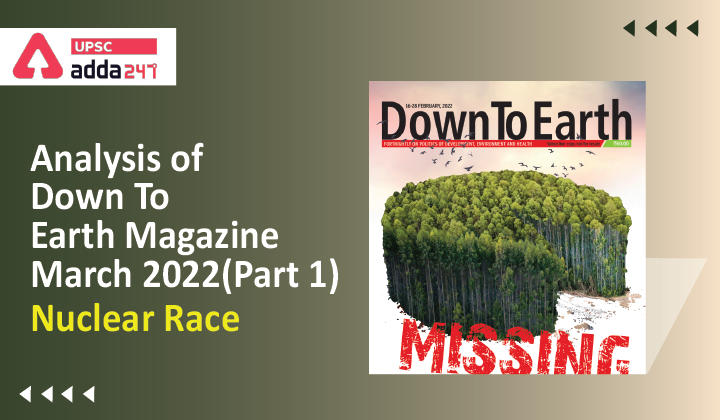Table of Contents
Analysis Of Down To Earth Magazine: ‘Nuclear Race’
”GS 1: Mineral & Energy Resources”
”GS 3: Nuclear Technology”
Introduction
- The space race has nations on their toes as they chart ambitious plans to go beyond the moon and Mars.
- They are all betting big on nuclear energy, touted to be the fastest and most efficient means of venturing into deep space.
- Nuclear batteries, Dubbed Radioisotope Thermoelectric Generators or RTGs, have been powering spacecraft for more than six decades.
A tricky energy source
- While countries are betting on Nuclear Power to transition out of fossil fuels by 2030, they are scared of it because of safety issues.
- Currently responsible for less than 10 per cent of the world’s electricity generation, nuclear power plants have already reported three major disasters—Three Mile Island, Chernobyl and Fukushima.
Key Concerns
- Experts warn that the lack of a robust international regime governing space reactors is troubling as nations increasingly invest in nuclear energy in space.
- The UN’s Office for Outer Space Affairs has provided a set of principles for deploying nuclear power sources in outer space. But it needs to establish guidelines for the safe use of atomic energy.
- Countries are also trying to develop spaceships that will use nuclear energy as fuel.
How Nuclear Batteries Works?
- They perform two key functions: providing power to keep the onboard instruments running and Supplying heat to protect the instruments from the cold environs of space.
- In 1961, the first RTG-powered satellite, the Transit 4A spacecraft, took off from the US.
- Since then, several nuclear-powered missions have been launched, including 25 from the US. Russia has also invested in this technology.
- In 2013, China soft-landed its RTG-powered Change 3 robot on the moon.
- NASA’s Perseverance rover, which touched down on Martian soil in 2021, is also nuclear-powered.
Beyond RTGS
- The global discourse is now moving beyond RTGs.
- The US and China plan to set up a nuclear power reactor on the moon to provide electricity for astronauts camping on the lunar body.
- In 2021, NASA invited proposals from industries to design nuclear power systems for lunar applications.
- By 2030, NASA plans to set up a plant that will continuously provide 10 kilowatts (kW) of power—the average annual power intake of a home on Earth.
- China is trying to build a reactor that can generate 1 megawatt (MW) of electric power.
- In 2021, the Indian Space Research Organization (ISRO) took its first step by inviting companies to develop a 100-watt RTG.
Small Modular Reactors
- In order to address the safety concerns, over 17 countries, including the US, China, Russia, and Canada, are trying to develop small modular reactors, or SMRs.
- There are over 70 commercial SMR designs that are at different stages of development.
- With a power capacity of up to 300 megawatt (MW) per plant, they constitute about one-third of the generating capacity of traditional nuclear power reactors.
- SMRs are being explored as an energy source in other sectors. For instance, they could potentially reduce the carbon footprint of the shipping industry, which emits more than one billion tons of greenhouse gas emissions per year.
- The naval force already uses nuclear energy for propulsion. India’s Arihant class of submarines is one example.
- SMRs could also produce hydrogen. Over 95 per cent of hydrogen comes from fossil fuels.



 TSPSC Group 1 Question Paper 2024, Downl...
TSPSC Group 1 Question Paper 2024, Downl...
 TSPSC Group 1 Answer key 2024 Out, Downl...
TSPSC Group 1 Answer key 2024 Out, Downl...
 UPSC Prelims 2024 Question Paper, Downlo...
UPSC Prelims 2024 Question Paper, Downlo...
